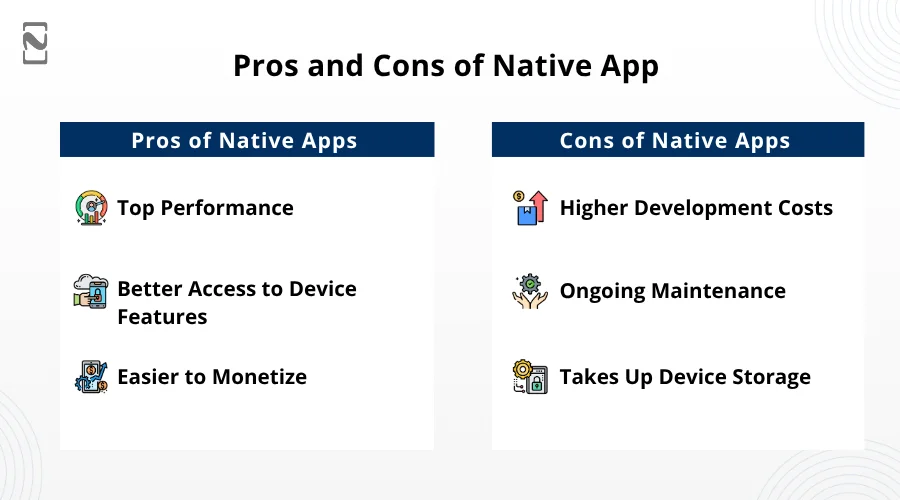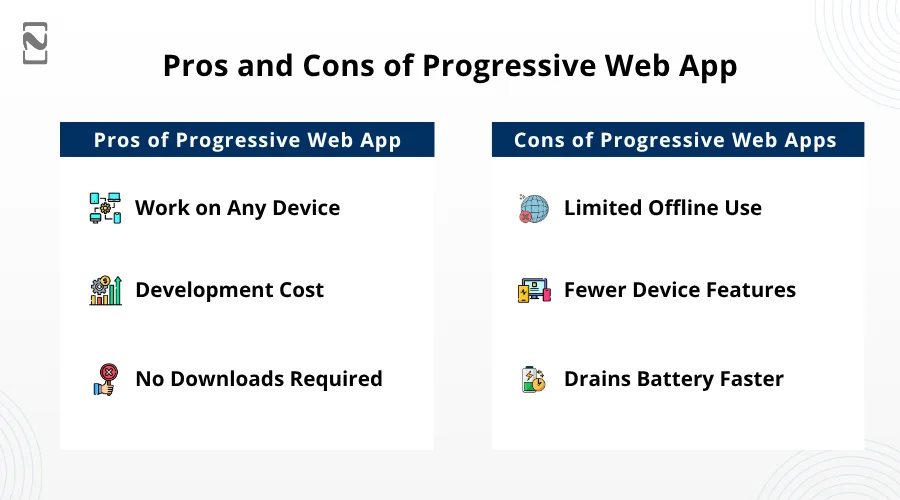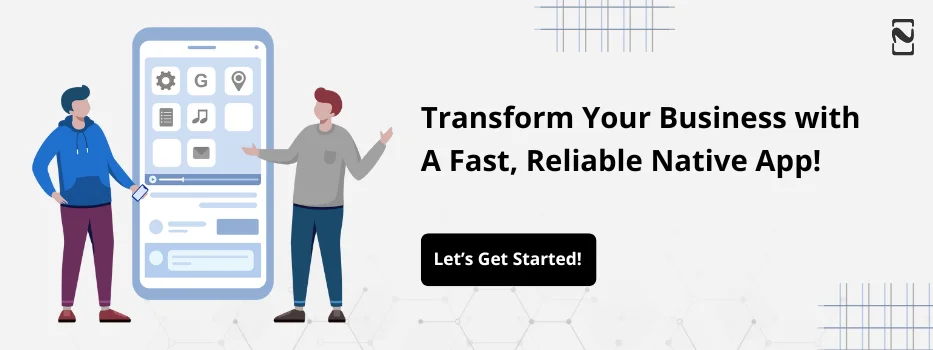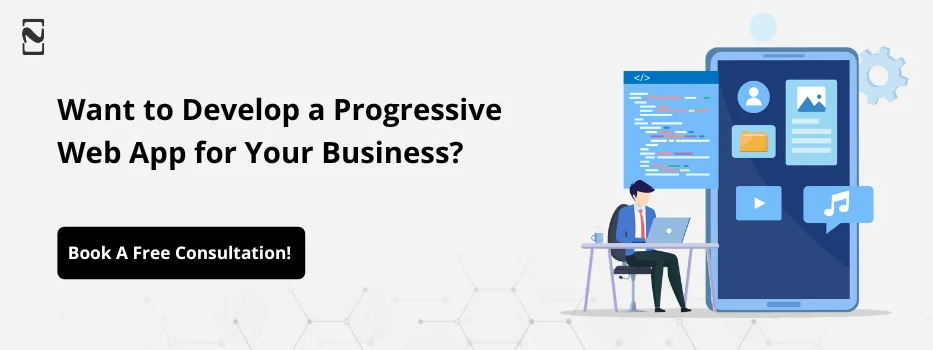Nowadays, more people use their phones to go online than computers. In fact, almost 60% of internet traffic now comes from mobile devices.
That’s a lot! And that’s why businesses are putting more focus on ensuring their mobile experience is really good.
Having a website that works well on smartphones is essential. However, for the best experience, some businesses take it a step further. You have two options: native apps and progressive web apps.
PWAs are kind of in between a website and an app. They do not need to be downloaded, but they will still be added to your home screen and work offline.
So, what’s better for your business: Native vs Progressive Web Apps?
In this blog, we will discuss the major differences so you can decide what’s best for your business.
So, let’s begin!
What are Progressive Web Apps?
Progressive Web Apps (PWA) mean a simple website that works like regular apps on your mobile phone, tablet, or computer.
You can simply open them in your web browser, but they feel just like native website apps. It is quick, reliable, and easy to use.
Additionally, you can add them to your home screen without downloading anything from app stores.
Progressive web apps provide more mobile app security than traditional web apps. This is because they have to operate under HTTPS.
PWAs use smart technology like service customers, web manifests to ensure they run smoothly and load fast, even if you are offline.
A recent report from Emergen Research shows that the global market for Progressive Web Apps was worth around $1.13 billion.
It’s expected to grow rapidly and hit about $10.44 billion by 2027, with an average yearly growth of nearly 32%.
Progressive Web App Examples:
- Twitter: Its PWA allows you to check your feed quickly and get push notifications, even when your internet is slow or you do not want to install the app.
- Starbucks: Starbucks has a PWA where you can see the menu, customize your order, and buy your coffee, all without needing to download an app.
- Pinterest: Pinterest has made its mobile site into a PWA, so it loads faster and works well on all phones, like older or slower ones.
- Uber: Uber’s PWA helps you book a ride fast, even if your connection is weak, and you do not have the Uber app installed.
What are Native Apps?
Native apps are applications made just for a particular OS, like Android or iOS. They are created using special programming languages that work best on those devices.
For example, Swift for iPhones, or Java for Android.
Since React Native app development is only for one system, they can use the phone’s features like GPS, camera, etc, really well, which makes them fast and seamless to use.
If you choose Android or iOS to build a mobile app, the code you write will not work on other systems. Native apps are made just for one platform.
You can see calculators or weather apps that come already on your phone.
Native App Examples:
- Spotify: A native app made for iOS and Android that allows you to stream music and podcasts smoothly.
- WhatsApp: A messaging app created natively for mobile platforms that enables fast texting and clear voice or video calls.
- Snapchat: A native mobile app designed for quick image and video sharing with features that work closely with your phone’s camera and storage.
Native vs Progressive Web Apps: Key Comparison
Are you trying to decide between a Progressive Web App vs Native app? We’ve broken down the 7 main differences to help you figure out which one makes the most sense for your business.
No matter if you are just exploring your options or diving into iOS or Android app development, this key comparison will help you make the right choice.
So, let’s take a look at the major differences between Native apps and Progressive Web Apps.
| Parameters | Progressive Web App | Native App |
| Platform Compatibility | Works on any device with a browser, phones, tablets, or computers, no matter the operating system. | Built separately for each platform, like iOS or Android, using different tools and languages. |
| Installation & Access | It can be used directly from a browser and added to your home screen without visiting an app store. | It must be downloaded from official app stores like the App Store or Google Play. |
| Device Features | It can use some phone features but has limits, especially with deeper system access. | Has full access to device functions like camera, GPS, notifications, and more. |
| Works Offline | It can work without the internet using built-in caching, but it depends on how the app is built. | Generally has stronger offline support, with more freedom to save and access content locally. |
| Development Cost | More budget-friendly, you can build once and run it on all platforms. | More expensive, requires separate development for Android and iOS. |
| Speed & Performance | Fast enough for most tasks, but can lag with complex features or graphics. | It’s generally faster and smoother, especially for complex apps like games or video editors. |
| Updates | Updates happen in the background; no need for users to download anything. | Users often need to download updates from the app store manually or automatically. |
Pros and Cons of Progressive Web Apps and Native Apps
Now that you know the major difference between a Progressive web app and a Native app.
It is time to learn about their pros and cons, which will offer a comprehensive overview of both the native vs web-based mobile apps and assist in selecting the right one for you.

► Pros of Native Apps
-
Top Performance
Native apps are developed specifically for the platform they run on. This means they are faster, seamless, and provide a better overall experience. You can also integrate complex features without hitting limitations.
-
Better Access to Device Features
Do you need full access to the camera, microphone, GPS, or Bluetooth? Hire react native app developers who can integrate features so users can click into all of that easily and reliably.
-
Easier to Monetize
Native apps are listed in app stores, which makes it simple to add in-app purchases, subscriptions, and payment options using built-in systems like Apple Pay or Google Pay.
► Cons of Native Apps
-
Higher Development Costs
Mobile app developers can develop separate versions for iOS and Android. This means more time, more developers, and more money. If you want your mobile app on both platforms, it is basically double the work.
-
Ongoing Maintenance
Updates, bug-fixes, and new features all require regular maintenance. You will need separate teams for iOS and Android. It is not just about developing the app; it is about keeping it up to date.
-
Takes Up Device Storage
Before users can try your app, they need to find it, download it, and install it. If the app is large, they might skip it altogether to save space on their home screen.

► Pros of Progressive Web Apps
-
Work on Any Device
PWAs are developed to run on all types of devices, no matter what OS you are using. For example, mobile phones, tablets, and computers. iOS, Android, Windows, it does not matter at all. Your app will look intuitive and work smoothly everywhere.
-
Development Cost
You only need to develop a PWA app once, and it will work on different platforms. This saves both time and mobile app development costs compared to creating separate apps for iOS and Android.
-
No Downloads Required
Users don’t need to visit the app store to get your app. Just click the link and it’s ready to use. This makes it easier to attract and retain users who may not want to install another app.
► Cons of Progressive Web Apps
-
Limited Offline Use
PWA can work without an internet connection, but only to a point. They can show pages you have already visited, thanks to caching. But if you need full online features, it would not match a native app.
-
Fewer Device Features
PWAs can’t access everything on your mobile phone. Features like Bluetooth, NFC, or contacts are not supported. So if your app needs deep hardware access, this could be a dealbreaker.
-
Drains Battery Faster
Since PWAs rely on the browser and are developed using web technologies, they tend to use more power. This can lead to faster after-drain compared to native apps.
When Should You Choose a Progressive Web App vs Native App?
When you decide between Native vs Progressive Web App, it’s vital to understand what each one brings to the table.
Both options have their own strengths and weaknesses. The right choice depends on what you are trying to achieve with your app.
So, let’s take a look at the PWA vs Native App to choose.
Consider going with a PWA if:
- You are in the early stages of your Android or iOS app development project and just need a clean, functional app to get started. PWAs are faster to build and easier to maintain. This makes them the perfect option for startups or small teams.
- Budget and time are the major concerns. PWAs can be built faster and usually cost less than native apps since you do not build separate versions for iOS and Android.
- You want to improve your brand’s online presence. PWAs are essentially websites that behave like apps, so they are easier to discover through search engines. The web-based app vs native apps can help with SEO and getting more users.
Consider going with a native app if:
- You are focused on developing a strong, professional brand presence. Having a native app in app stores can provide your project with a more established and trustworthy feel.
- Your app needs access to advanced phone features like the camera, GPS, etc, which PWAs may not fully support. Native apps are better equipped to handle this kind of functionality smoothly.
Still Not Sure? Let Nimble AppGenie Help You Choose the Perfect Fit!
Are you still feeling stuck between going with a Progressive Web App vs Native Apps? Well, you are not alone; it is a decision that depends on more than just features.
Things like budget, user experience, and plans all play a crucial part. That’s where Nimble AppGenie steps in.
We do not throw one-size-fits-all solutions at you. As a hands-on PWA development services provider, we take the time to understand your idea and help you figure out what is right for your business.
We have worked with startups and established companies around the world to create fast, user-friendly web apps and native applications.
Our professional team takes the time to understand your vision and guides you toward the best solution, whether that’s a PWA, native app, or something in between.
So, what are you waiting for? Book a free consultation with us for your dream project.
The Verdict: Which is Better, PWA or Native App?
In the end, there is no one-size-fits-all answer. PWAs are great if you want a quick, cost-effective solution that works across devices.
On the other hand, native apps offer the best performance and deeper access to device features, making them best for complex apps.
So, choosing the right platform for your app is essential because it can affect your app’s performance and business growth.
If you want a native approach but also need to save time and money, React Native for app development is a popular option.
However, if you are still unsure which one, the web app or the native app, is the best fit for your project, then it is best to consult with a reputable mobile app development company that can help you make the right choice.
FAQs

Niketan Sharma, CTO, Nimble AppGenie, is a tech enthusiast with more than a decade of experience in delivering high-value solutions that allow a brand to penetrate the market easily. With a strong hold on mobile app development, he is actively working to help businesses identify the potential of digital transformation by sharing insightful statistics, guides & blogs.
Table of Contents






No Comments
Comments are closed.